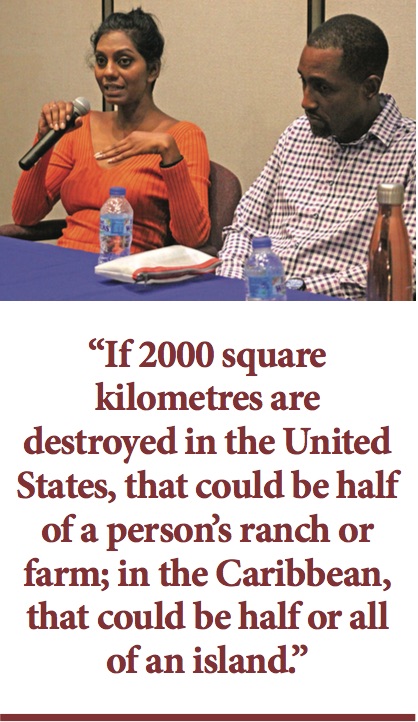How do you contend with living in a space that is particularly vulnerable to climate change, while seeking to maximise use of the limited resources available? The answer is not simple; it is not black and white.
Malini Maharaj, Assistant Lecturer in the Department of Economics at the Faculty of Social Sciences, posits that the answer cannot be found in a textbook. She believes the answer can only come from local knowledge, ideas, and innovation.
Maharaj spoke recently at the event, “Building a more Resilient Caribbean: A panel discussion on Climate Change” The discussion was hosted by the International Affairs Committee (IAC) of the UWI St Augustine Guild of Students. “Context is a vital consideration when speaking of resilience in the Caribbean,” she said.

In the Caribbean context, the major sources of income are all natural resource-based. The economics lecturer explained that, once something happens to the environment, there will be complications in how Caribbean nations create income.
More importantly, the region must be cognisant of the vulnerabilities created by climate change in these spaces. The ramifications are not just economical but also social.
Maharaj recommends a realistic approach in seeking to protect our environment. “The economics make it a little bit difficult or a little bit more challenging to be as ambitious as we would like to be.”
The economics lecturer illustrated the point anecdotally. A hungry man cannot be told not to cut down a tree if that is his only source of income to buy food. In spite of all of the wider environmental benefits that can be garnered from allowing this tree to grow, it is the only foreseeable source of income.
Deputy Dean of Outreach and Internalisation at the Faculty of Food and Agriculture, Dr Gaius Eudoxie, identified three components of vulnerability: size, location, and exposure.
The Caribbean is an explosion of culture that is known worldwide. However, the nations of the Caribbean occupy a relatively small amount of land space. In a comparative sense, therefore, size does matter.
“If 2000 square kilometres are destroyed in the United States, that could be half of a person’s ranch or farm; in the Caribbean, that could be half or all of an island.” As a result of this, Dr Eudoxie said, land is a very important factor when considering resilience in the Caribbean.
Expounding further, he explained that land is an aggregate resource that is finite. In the context that much of the economic activity of Caribbean nations is intrinsically dependent on land usage, climate change is not the only element affecting the land. The use, misuse, and overuse of the land must be considered as well since all of these affect to what extent, if any, Caribbean nations can prepare for any adverse impact.
“There’s not enough discussion on resilience at the preparedness stage,” the Deputy Dean stressed. While the outlook for the Caribbean looks bleak due to its susceptibility to natural disasters, the Deputy Dean believes all hope is not lost.
Dominica is a case in point. Following the catastrophic effects of Hurricane Maria on Dominica in 2017, that country presented a rebuilding solution that revolutionised the way it looked at hurricane-preparedness.
Dominica established the Climate Resilience Executing Agency of Dominica (CREAD), which is essentially a statutory government agency that focuses on coordinating a single climate-resilient recovery plan for Dominica.
The key is in recognising the vulnerabilities that exist and focussing efforts on building preparedness and engaging in better practices.